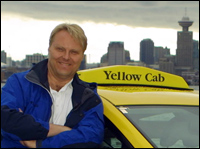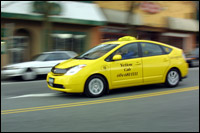Like any self-respecting cabbie, Andrew Grant has a talent for small talk. But when the conversation turns to his prized 2004 Toyota Prius, things get a bit more animated.

Andrew Grant.
“Gave Cameron Diaz a lift once,” he says matter-of-factly, leading me toward the Vancouver curb where the curvaceous car is parked.
“Oh, yeah? What did she say?”
“She said, ‘This is nothing, I’ve got two.'”
“What — two hybrids?”
He pauses just long enough to keep things respectable: “Yeah.”
Fame, as Andy Warhol once so eloquently opined, is a universal phenomenon, and Grant boasts his own rather lofty claim to it, with oodles of dashing self-confidence. While Cameron Diaz might have made an environmental name for herself driving a hybrid and Trippin’ all over the planet, this Canadian cab operator has been carving out his own niche: he is the (self-proclaimed) world’s first hybrid-taxi driver.
The humble hybrid has come a long way since it was introduced in North America in 1999. Last year, sales of the gas-electric vehicles topped 80,000 in the U.S. And while the efficient cars have proved popular with eco-minded commuters and day-trippers, those who make their living behind the wheel have even more reason to believe: it just makes good business sense.
Last year, a diesel/electric version of London’s famous black cab was launched on the British capital’s streets. In February, San Francisco added 15 hybrid Ford Escapes to its fleet. Not to be outdone, New York’s City Council recently voted to begin greening the Big Apple’s nearly 13,000 yellow cabs. It’s a move that, according to a recent Sierra Club report, could reduce emissions of global-warming pollutants in the city by up to 50 percent.
To Grant, of course, all this is old hat. “Got my first Prius in November 2000,” he tells me, lifting up the hood of his well-polished model to allow me a peek inside, where I see an engine so clean I could quite conceivably eat my dinner off of it. It soon becomes clear that the Vancouver resident is no fly-by-night fan. “I first started tracking the hybrid prototypes in the early 1980s,” he continues. “So when the Japanese brought out the original commercial model in 1997, the benefits seemed obvious. Firstly, the car was environmentally friendly, and secondly — as far as taxis go — it was far more cost-effective.”

The Prius will free us.
Grant — a one-time car salesman who, when he’s not driving, is studying to be an executive business coach — is on his third Prius now. (Toyota, seizing a chance to evaluate the car’s durability, took his original back after he’d driven it 200,000 miles in 25 months and exchanged it with a 2003 model, fully outfitted for fares.) Compared to conventional taxis, his current 2004 Prius saves between $900 and $1,100 per month in fuel costs alone, and his repair bills — thanks to automotive innovations such as regenerative braking, which reduces wear and tear on the brake pads — have been cut by more than half.
Though he would prove to be a profit prophet, Grant says he faced uncertainty in the early days. Despite local intrigue — the downtown Toyota dealership used to call him over to show off his rare vehicle to tentative buyers, and even give test drives — his peers viewed the move as akin to sticking his head under a well-oiled guillotine, and customers were leery. “People looked upon it as a kind of glorified golf cart,” says John Palis, general manager of Yellow Cab Company, under whose umbrella Grant operates. But as the car grew more popular, attitudes changed almost overnight — in Vancouver, at least — and, says Palis, “the vehicle became cool.”
Yellow Cab, British Columbia’s largest taxi operation, now counts more than 40 hybrids in its fleet of 210 cars. “We’re currently [planning to convert] approximately 25 to 30 of our vehicles over a year,” Palis tells me from his busy East Vancouver office, where phone lines buzz and drivers saunter in and out to shoot the breeze with their amiable boss. He says customers have, for the most part, been pleased with the ride: “These days, we tend to get two main reactions when they initially get in. They are surprised by the size of the interior — trunk space, leg room, etc. — and they are freaked out by the lack of noise.” That disquieting quiet is a consequence of the vehicle switching over to its battery-operated electric engine when idling or in slow-moving traffic.
To get a taste of the action, I accept an offer to test the hybrid-cab waters with Amarjeet Kang, alias “Chico” — Grant’s cab-sharing colleague, whom he has summoned on his ever-buzzing Blackberry to take me out for an introductory spin.
Tooling through Vancouver’s low-rise Mount Pleasant district in the spotless vehicle, we get into a prickly altercation with an SUV at a four-way stop a few blocks west of Cambie Street. “My right of way!” exclaims Chico over the silent motor, a wave of the hand suggesting that he’s not over-enamored with the idea of getting summarily shrink-wrapped.
The confrontation is quite telling. Vancouver, a city known for being clean and green, is also host to a rampant proliferation of SUVs. In a country where the average family size is a mere 1.5 children or fewer, parents seem to like their cars big and brash. But with oil prices surging and the U.S. government finally admitting that global warming might be something more than a storm in a teacup, the Edwardian summer of the SUV must surely be drawing to a close. And waiting in the wings, the once lowly hybrid is ready to fight back.
As far as Grant is concerned, the fight is already on. “I’d say 30 percent of my business now comes from ‘green’ customers,” he says. “That is, people who specifically dial me up for environmental reasons.” Included in this eco-roll call are local stalwarts Greenpeace Canada, the David Suzuki Foundation, the British Columbia Children’s Hospital, and tech giant Ballard Power Systems, a leader in the development of zero-emission fuel-cell technology.
In short, hybrids save gas, save money, and might just change North America’s city streets. But above all, says Grant, his history-making Prius is “a fun car to drive. Because of the electrically assisted steering you don’t get any tug on the wheel. A day in the driver’s seat, and I’m still not feeling tired.”
For cab drivers the world over, that might be the best news of all.


